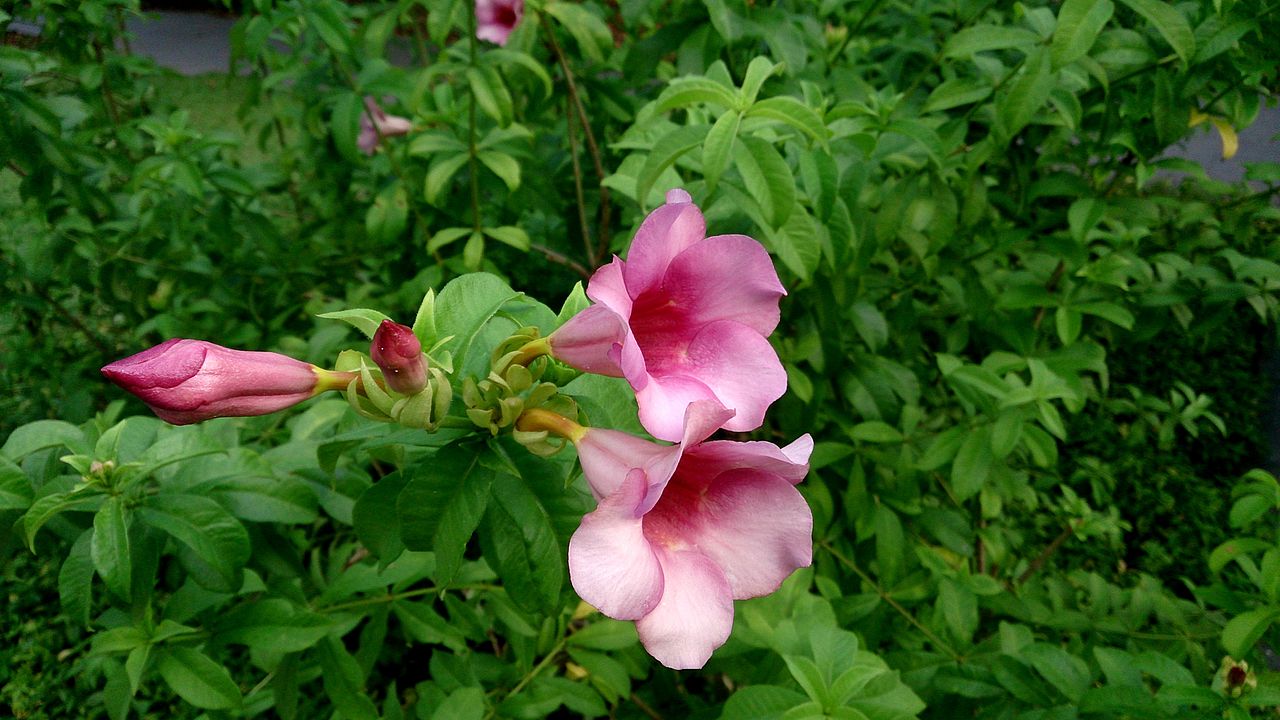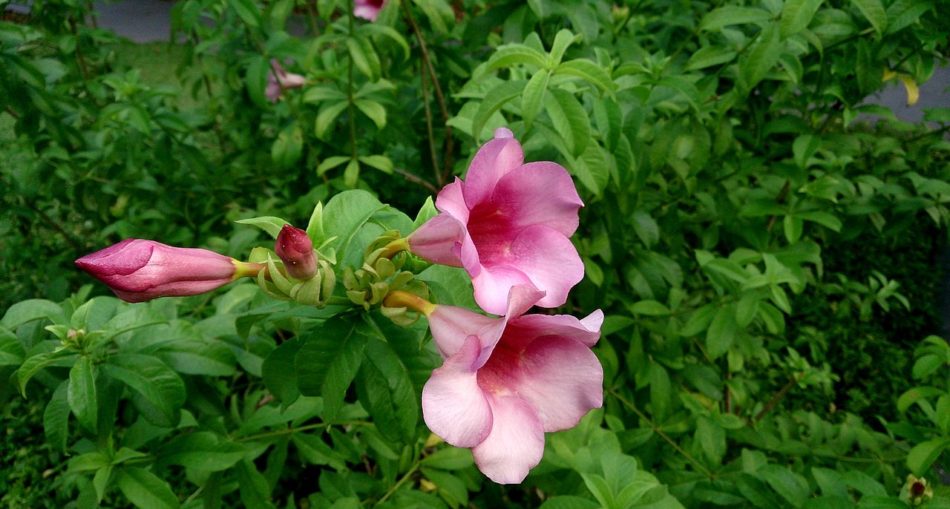You can find plants of the Allanmanda genus across Guyana. Allanmanda is the genus of plants under which the various species is categorized. The Golden Trumpet or the Yellow Bellflowers are the most common and captures your attention with their vibrant colours. While yellow is the most popular colour of these flowers you can also find the less common Purple Allanmanda. The purple blooms are usually streaked with white but are just as beautiful as the other flowers. Allanmanda are grown in hedges which are regularly trimmed and you can find them particularly in the countryside of Guyana.

Purple Allamanda -Photo by: By Mokkie – Own work, CC BY-SA 3.0, https://commons.wikimedia.org/w/index.php?curid=33646951
Origin of Allamanda
Allamanda is native to South America and North America grows in countries like Guyana, Brazil, Argentina, Costa Rica, the Galapagos Islands, and even in Mexico and as far as Australia.
Scientific Classification of Allamanda
- Kingdom: Plantae
- Clade: Tracheophytes
- Clade: Angiosperms
- Clade: Eudicots
- Clade: Asterids
- Order: Gentianales
- Family: Apocynaceae
- Genus: Allamanda
Description of the Allamanda
Allamanda is an evergreen plant, which means it remains green all year round. The plants of the same genus are vines with the exception of Allamanda schottii which is a shrub. It can grow as high as eight (8) feet and is typically around six (6) to eight (8) feet wide though it can be regularly pruned and shaped into a hedge. The leaves grow about four (4) to eight (8) inches in spirals. Prickly green seed pods also grow on the trees but blend in with the leaves. Flowers are typically five (5) inches big with a slender tube The corolla of the flower is varies according to its species but pales as it reaches the ends of the bloom.
Species of Allamanda
- Yellow Bellflower – The Yellow Bellflower is also called the Golden Trumpet because it resembles the conical but flaring shape of the musical instrument called a trumpet. It is also known as common trumpet-vine, and yellow allamanda, however, the scientific name of the flower is Allamanda Cathartica.
- Purple Bellflower – The Purple Bellflower is a gorgeous combination of dark purple, almost burgundy and white. The scientific name for this species is the Allamanda blanchetii. It is a fast-growing plant.
- Allamanda doniana – Allamanda doniana goes by its scientific name and like other plants in its genus, it can be poisonous.
Interesting Tip
- Butterflies on the genus Phoebus predominantly pollinate the flowers but wasps and bees also visit the flower.
- A milky sap which is an irritant can be found in the leaves and stems
- Plumericin, also contained in the plant, gastrointestinal irritation.
- Allamanda was named after Dr. F. Allamanda, who was a professor of natural history in Leyden in the latter part of the 18th century.
- If ingested the plants may induce vomiting or diarrhoea.
- The bark contains tannins.
Uses of the Allamanda
- Herbalists use plants of the Allamandagenus to treat jaundice, malaria and even constipation.
- Antibiotic properties of the plant are effective against staphylococcus.
- Yellow Bellflowers are sometimes used by the Hindus in worship.
- The leaves of Allamanda can be used as an external medicine in the treatment of diseases like abscesses, eczema, ulcers and ringworm.
- Allamanda is believed to have wound-healing abilities, purgative effects anti-proliferative effect, anti-microbial, cytotoxic, and a synergistic anti-inflammatory effect however it is toxic when incorrectly used.
- The plant is also preventative medicine.
- Yellow Bellflowers are usually grown and shaped into hedges to decorate lawns.
- This plant is mainly used as ornamentals.
About Allamanda
The Allamanda genus comprises of several magnificent species of flowering plants. Plants that belong to the Allamanda genus are distinctive from any other species of flowers in Guyana. This is because they have unique flowers, which are shaped like bells. The Yellow and Purple Bellflowers are the most popular species and are differentiated by their colours after which they are named. Because they belong to the same genus of Allamanda, the different species share many characteristics like their toxicity and trumpet-like shape. Any species of Allamanda will definitely make a great hedge to keep that nosy neighbour out!
Article References
- https://www.hunker.com/12000182/description-of-the-yellow-bell-flower
- https://en.wikipedia.org/wiki/Allamanda
- http://florawww.eeb.uconn.edu/198500393.html
- https://benefitsplantforhealth.blogspot.com/2017/01/benefits-golden-trumpet-common-Characteristics-Direct-to-benefits-Neutralizes-free-radicals-Active-kill-bacteria-Cure-liver-disease-Liver-Disease-Treating-skin-disease-Reduce-swelling-used-is-the-roots-leaves-and-flowers-for-the-treatment.html
- https://www.gardenia.net/plant/allamanda-blanchetii
- https://www.rhs.org.uk/Plants/791/i-Allamanda-doniana-i/Details
- http://tropical.theferns.info/viewtropical.php?id=Allamanda+doniana







